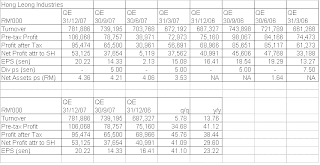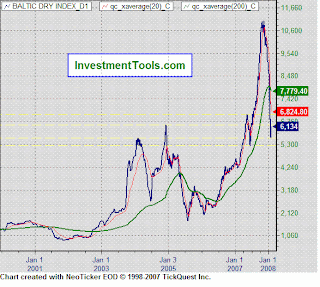Century has just announced its results for 4Q2007 ended 31/12/2007. For QE31/12/2007, its net profit increased by 231% y-o-y from RM1.8 million to RM6.0 million on the back of a 36.4%-increase in turnover from RM32.7 million to RM44.6 million. When compared to the immediately preceding quarter, its net profit has declined by 12.1%. The drop was attributable to the company recognizing some deferred tax assets in QE30/9/2007, thus boosting the net profit. As you can see, the pre-tax profit for QE31/12/2007 had in effect increased by 26.7% q-o-q from RM6.1 million to RM7.8 million.
For FY2007, Century's net profit declined by3 folds from RM5.1 million to RM20.7 million, while its turnover has increased by 30.0% from RM125 million to RM161 million.

Century (closed at RM1.65 as at Feb 28) is now trading at a trailing PE of 4.0 times (using its last 4 quarters' EPS of 41 sen) or at a Price to Book of 0.8 times (using its NTA per share of RM2.09 as at 31/12/2007). At these multiples, Century is deemed cheap.
Century had risen from 60 sen in October 2006 to a high of RM2.80 in September 2007, The current correction could see the share price testing the horizontal supports of RM1.60 & RM1.30. The uptrend line support is at RM1.35-40.

Chart: Century's daily chart as at February 27, 2008 (courtesy of Quickcharts)
Yesterday, Century-WA ceased trading due to its expiry. In the last few days of trading, this warrant appears to be accumulated at prices around 55-60 sen. Normally, an expiring warrant is purchased by knowledgeable investors or insiders. These buyers will have to pay RM1.00 to convert the warrants to shares; thus their cost is about RM1.60. They have to be fairly confident to go through this exercise, given the present bearish market outlook. As such, Century could be a BUY for the medium-term at prices near to RM1.60.
Note: Century closed at RM1.81 at the end of the morning session.











































